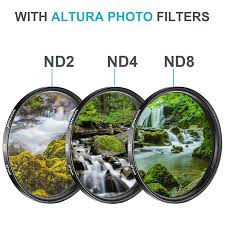Shooting nature and landscape photos with black and white film using red, green, and yellow lens filters is very interesting. It is amazing to see the different results. With color photography there are many choices, but my favorites are the polarizing lens filter and the neutral density lens filter. Both of these can be used with color or black and white where the colored lens filters are for black and white only.
A polarizing lens filter will deepen a blue sky and may enhance colors in your nature and landscape photos. The blue sky is polarized light, so the use of a polarizing lens filter can darken the sky. But an overcast sky is not polarized light so a polarizing lens filter will not work on cloudy or overcast days. A polarizing lens filter can also cut down glare and reflections from water or glass. In my opinion a polarizing lens filter is a necessity in every photographer’s camera bag.
Neutral density lens filters are used to reduce the amount of light entering the camera lens. Example, it is a bright sunlit day and your camera’s light meter reading says 1/1000th shutter speed and f/11 aperture. You want to use a shallow depth of field to emphasis your subject, but f/11 gives you too much depth of field. By using a 4-stop neutral density lens filter you reduce the light entering the lens so you can shoot your photo at f/2.8 giving you the depth of field needed.
Some photographers use a skylight lens filter to protect the camera lens. It protects the lens from scratches and does not affect the color of light entering the lens and can be used with color or black and white.
When buying a lens filter remember there are different sizes, make sure the lens size is correct so the threads of the lens filter will fit your lens. The lens filter size is the diameter of the lens not the focal length. Both the size and focal length are in millimeters. Two of my lenses use 55mm lens filters and one uses a 52mm lens filter. Since I had the larger diameter lenses first and bought 55mm lens filters I use an adapter-ring to make the 55mm lens filters fit the 52mm lens. Lens adapter-rings are either a step-up or step-down ring depending which way you need to go. Your camera lenses will have the lens diameter stamped on the front of the lens.
You don’t need an arsenal of lens filters to shoot more photos. Of the three lens filters I have mentioned the polarizing lens filter is probably the most useful to the nature and landscape photographer. Just make sure to check all your camera’s lenses for the correct diameter of lens filter.
The Best Lens Filter Photography Tips
 Reviewed by Ismail Fahmi
on
July 26, 2020
Rating:
Reviewed by Ismail Fahmi
on
July 26, 2020
Rating:
 Reviewed by Ismail Fahmi
on
July 26, 2020
Rating:
Reviewed by Ismail Fahmi
on
July 26, 2020
Rating:







No comments:
Post a Comment